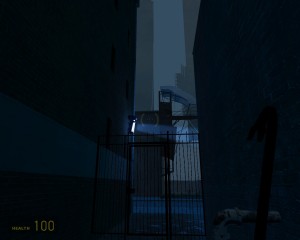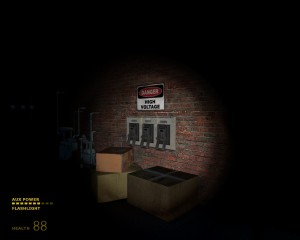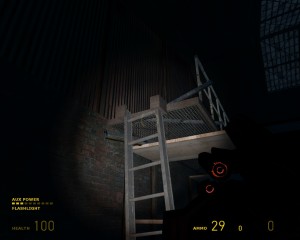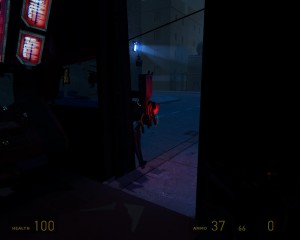This was the final team project for my Level Design 2 module in university. The brief was simply to create a level that felt like an existing Half-Life 2 level, using pre-existing assets. After looking at some of the levels in HL2, we had a decent idea of the pacing Valve used – the average ratio of combat-to-puzzle gameplay is approximately 2:1 in favour of combat, though this does vary between sections of the game. During combat sequences, we found that the Combine enemies usually attack in groups of four or five, with the occasional lone ambusher thrown into quiet sections to shake things up. Moreover, enemies which appear in groups often attack in succession, rather than all at once, usually at intervals of three to ten seconds.
Armed with this knowlege, we decided to make a fairly straightforward level in which the player would work their way through a small section of an urban environment towards a mounted sniper rifle on a rooftop, which they would then use to pick off the guards around a hostage.
We decided to begin the level with a briefing; as the player works their way around behind the building the hostage is being held in, a voiceover explains the level’s goal to them, to ensure they’re aware of the objective. As they exit the alley, they come upon the scene of the first puzzle, as well as a lone Combine Metrocop, placed there to provide the player with a submachinegun before the first main combat sequence.
This puzzle is a fairly simple one, but one which is designed to play on the player’s expectations. They have to gain access to the power substation in order to reactivate lighting in the adjacent apartment building, but the door is locked. They can see a large skylight on the roof, which suggests itself as a possible ingress point. Firstly, they will tend to try and climb the orange generator to the scaffolding… at which point it collapses. In doing so it makes the blue barrels that were sitting atop it available to the player, who can then use them to climb the green skip onto the roof.
Once on the roof, the player can see into the adjacent yard, but cannot access it. They can however, see a fallen shipping container which it should be possible to climb across to get past the fence.
By dropping through the skylights on the substation, they can enter the building, triggering another voiceover which informs them they ought to search for the main circuit breakers. The room is somewhat cluttered, but the breakers are visible on one wall beneath an attention focussing warning sign.
Throwing the breakers does nothing, much to the consternation of the player’s support voice, which instructs them to try and find a junction box and check the wiring. Opening the nearby junction box reveals a surprise – the Combine have attached a technobabble powered inhibitor to the circuit. The player is instructed to remove it, at which point it begins to flash and beep. Players with swift reflexes will throw it into a handy corner, but slower ones will suffer minor injuries when it explodes in their hand
Once the inhibitor is removed, throwing the breakers again will activate the generators, shaking loose a rusted ladder and allowing the player to climb up through an airvent and drop out onto the shipping container.
They then find themselves into what appears to be some kind of cargo-moving yard, outside a large warehouse. A small sign to the left of the doors warns them of a crane overhead – a warning of things to come.
The warehouse appears to be fairly ordinary when the player first enters it, however things rapidly take a turn for the dramatic – the lights go out two at a time with dramatically appropriate (and moderately nonsensical) clunking noises, and the door slams shut behind them.
The door of the small office at the rear of the warehouse is blown off its hinges, and flares come smashing out of the windows to illuminate the warehouse. This effect turned out not to be quite as good as I’d hoped. It turns out that the actual flare entity in HL2 provides very little light, and the scene in which Valve used them in the ‘Nova Prospekt’ prison level was also illuminated by dynamic light entities placed separately. Naturally I tried this myself, but due to the switching lights in the warehouse the area exceeded the number of light sources per face that the engine could handle, resulting in some horribly glitchy effects. Had it been permitted by the terms of the assignment I’d have made a mod, so I could simply alter the brightness of the flare entity in its sourcecode. Instead I ended up settling for the dimmer flares, which still provided a dramatic effect.
At this point, a half dozen combine soldiers come storming into the room, beginning the first major combat sequence of the level. This battle was sometimes criticised as being overly difficult, and had I had more time to test and refine the level I’d probably have made it easier. Nonetheless, by careful use of the environment, the player will triumph.
At this point, the player will most likely try and leave through the office from which the soldiers emerged. Unfortunately, the exit is blocked by an APC, which will rapidly kill the player if they attempt to loiter in front of the doorway.
When the player heads back into the main floor of the warehouse to search for an alternate route, a shouted warning to “look out above” directs their attention towards the large skylight in the centre of the roof.


This particular sequence was one of the hardest to get right – too much detail on the skylight and shelves made it hopelessly laggy when it happened, but too little didn’t create enough debris and chaos to make the scene dramatic. Furthermore, HL2’s physics are somewhat touchy, and we often encountered moments where the container would lodge on a splinter or a small shard of glass with one corner poised ridiculously in the air… then it would leap violently across the room without warning, often crushing the player. We eventually managed to get it working fairly reliably, although it was impossible to prevent it from occasionally landing balanced on one end.
After the container comes to a halt, a combine dropship swoops in from above, and soldiers rappel down to the floor of the warehouse, cuing off another firefight.
If you examine the second shot closely, you can see a rappel line standing next to the descending soldier. It seems that the physics behind those ropes is a little peculiar – I doubt they were ever actually intended to be placed in such an open area for the player to view, and so they sometimes stand on end like solid poles before vanishing. Unfortunately, it was a problem we were unable to fix or conceal, but in the end we decided it was a worthwhile trade-off for the sake of the set-piece.
Once the player has defeated this wave of enemies, it’s time to find a way out of the warehouse. The doors they entered by are locked, and the back door is blocked by the APC. A search will show an air vent in the wall above the office – the player can get to it either by shooting the padlock off the ladder leading to the catwalk and jumping from their to the office, or by stacking crates and barrels to build steps.
Once they drop out of the air vent, the player lands in an alleyway behind the warehouse. One end is walled off, but the other end leads onto the street – alas, this end is blocked by a Combine forcefield. So, it’s time for another puzzle! The only way the player can go now is into the office building in front of them.
When they do, a large hole in the cieling to their right will eventually catch their attention. I realised later that I’d failed to place any debris beneath the hole, making it slightly out of place, but as none of our testers commented on it I assume it wasn’t overly noticeable. When the player approaches the hole, they can see some pipes leading from a closet along the wall, with a large red valve mounted on them, and a sign saying “No Smoking” on the wall above. If the player turns the valve, the pipes start to leak gas into the air.
If the player heads upstairs, they’ll find a loose wire on the cieling, and a switch wired up to a fusebox. Throwing the switch will set the wire sparking.
At this point, shooting or hitting the sparking end of the wire causes it to break loose from the ceiling and fall into the leaking gas pipe, blowing open the wall.
When the player works their way back downstairs, they’ll find that the newly holed wall leads onto a Combine control booth of some kind, but that walking through a large gas fire is a Bad Idea. Shutting off the valve stops the fire though, and they can proceed into the next area.


Unfortunately, the only door leading out of here is locked, and the player can’t use the computer. Still, there are three ways of interacting with things in Half-Life 2: the action button, the gravity gun, and bullets. Option three provides an exit.
In retrospect, this whole section feels rather contrived. The hole in the floor makes no sense, since the building is otherwise in nearly perfect repair. The inexplicably placed leaking gas pipe is silly, as is the odd wire that appears to just ascend into the roofspace for no real reason. Once the player blows up the wall, the pipe remains; jutting out unharmed. Additionally, it’s bizzare that the player can’t simply turn on the gas and detonate it with gunfire as is possible in Half-Life 2. I think the overall idea for the puzzle was an acceptable one, if not brilliant, but it was poorly implemented and unconvincing. Shooting the computers to open the door was also rather nonsensical – most testers tried it immediately after they realised they couldn’t just use the action button, but just because it’s a traditional solution in games doesn’t mean it makes sense.
In any event, the player is nearing their goal. Directly across the street from them, a set of stairs lead into the basement of the apartment building that they must scale.
To their right a set of fire escapes are visible, hinting at a means of reaching the roof.
When the player enters the basement, they are warned that the building is fortified, and that they ought be wary of traps.
These trip mines incidentally, are implemented differently to the ones used by Valve in ‘Nova Prospekt’. While Valve have an invisible trigger volume that acts to detonate the mine, I simply used the tripwire function of the laser beam entity.
When the player exits the basement (with or without being blown up), they will find the ground floor empty save for a medkit placed to patch up any mine-related injuries they may have sustained. Moving up the stairs towards the roof is met with an ambush:
The mounted gun in the second image is intended to drive the player towards the right as they reach the top of the stairs, but our testing shoved it never seemed to work that way. Players would persistantly charge down a narrow corridor with no cover towards the mounted gun on their left, never even thinking to look to their right. It gradually emerged that the general assumption was that they were supposed to eliminate every enemy. Because of this I added the wall of rubble that can be seen in the image, and made it entirely impassable.
When the player proceeds to the right, they find themselves in a small apartment. Moving further in to it triggers an ambush by a pair of enemies.
When they have been dispatched, a voiceover warns the player of enemies coming from below, and instructs them to use the fire escape. In the shot above, the window behind the Metrocop firing at the player has been blocked off with a metal hatch. In earlier iterations of the map, a desk and chair were sat directly beneath this window, and we noted a distressing tendancy for players to leap out of it and break both their legs on the pavement below – they weren’t remembering where the fire escapes were after seeing them earlier, and they weren’t looking before jumping out. In order to prevent this, and guide them to the correct window, we blocked this one off with a hatch, and moved the desk and chair to sit beneath the window leading on to the fire escape.
As the player climbs the fire escape, they can see soldiers rushing up behind them from beneath, impelling them to get to the next floor as quickly as they can.
Doing so leads them through a nondescript apartment and back on to the main stairway, where a loud buzzing and grinding warns them of an impending ambush by Manhacks.
After fending these off, the player enters the final combat puzzle of the level.
A laser tripmine, like the one at the top of the ladder is placed directly to the left of the door, encouraging the player to head for the table and chairs in the corner.
This leads them into the firing line of the turret set up next to the kitchen counter.
The natural impulse then is to run across and behind the counter, out of its effective area.
Where they find another mine, planted to prevent exactly that.
If the player doesn’t get caught out by this trick though, it’s quite easy to hop up on the counter and tip the turret over.
And then, it is time to confront the enemy behind all these traps! The apartment appears empty, but the bathroom door is closed…
As the player approaches it, a hovering robot bursts in through the window.
And takes their photograph, blinding them momentarily.
At this point, the last soldier bursts out of the bathroom and attacks the player.
Quick reactions and cool thinking will make short work of him, however, leaving the path to the roof clear at last.
The mounted sniper rifle on the roof is conveniently aimed towards the building with the hostage in. Using their zoom button, the player can see their targets in the darkness.
When the player picks up the rifle, their support character turns on the lights which they restored power to earlier, momentarily blinding the guards and giving the player just enough time to kill them both.

And that’s the end of the level. Had I been making this as part of a larger project, I’d have lengthened it to include the player escaping from the area, but we only had a limited time for the assignment, and didn’t want to bite off more than we could chew.
Overall, I’m quite satisfied with this level. There were sections such as the office, which were somewhat out of place or contrived, but for the most part I felt it held together. More importantly I still find it quite fun to replay, even after all the testing – the set pieces came out quite well, even with the dim flares and glitchy rapelling lines, and the puzzles are different enough from crate-stacking to serve as nice breaks between the fights.

















































